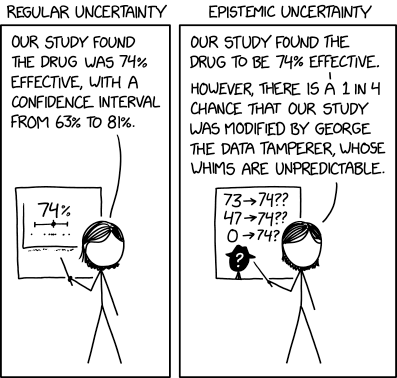Epistemic Uncertainty

Luckily, unlike in our previous study, we have no reason to believe Evangeline the Adulterator gained access to our stored doses.

Luckily, unlike in our previous study, we have no reason to believe Evangeline the Adulterator gained access to our stored doses.
In statistics, a confidence interval is an estimate which provides a range of values. These values are based on the statistical probability that the data collected represents a certain result. The confidence interval is a reflection on the uncertainty imposed by the limits of study sample sizes. No study will ever have an infinite data set.[citation needed] As a result, it is possible for different studies to give slightly different results. Averaging the results of multiple studies can give a result that is probably more accurate. The result given may still be skewed. A small skew is more probable than a large one, though. For example, if a drug was 80% effective it would be possible for several small studies to show a spread of different results with an average of 74% effectiveness. If the drug was 99% effective it would still be possible to randomly end up with the same data. However, this would be highly unlikely. This gives us a spread of "likely" predictions. Predictions outside a certain interval are considered too unlikely to be realistic.
George the Tamperer and Evangeline the Adulterator (from the title text) are analogous to the characters from Alice and Bob cryptography thought experiments. In the most basic examples, Alice and Bob are communicating. A third party, Eve the Eavesdropper, is spying on them. Both George and Evangeline have the ability to alter the study's results. George and Evangeline add uncertainty to the final data product. Specifically, they add epistemic uncertainty.
Epistemology – unlike epidemiology – is the branch of philosophy related to knowledge. Thus epistemic uncertainty is the ultimate impossibility to be sure that what we know is accurate. We are not unsure what is accurate because of failures in measurement. We are unsure what is accurate because of the intrinsic limits of knowledge. It seems that the "epistemic uncertainty" data has a 25% chance of data tampering by George. In the previous study, the data is known but its reflection of the general case is uncertain to an extent. In contrast, in this study even the knowledge of whether any single data point is correct is uncertain. Thus, their data has a 25% chance of being incorrect. There is no possible statement about how incorrect it may be.
The title text mentions an individual called "Evangeline the Adulterator." She adulterates their drug doses. If this happened, the researchers would not even be sure the patients received the dosages (or exacting medicines/placebos) as prescribed. The study methodology itself would be in doubt.